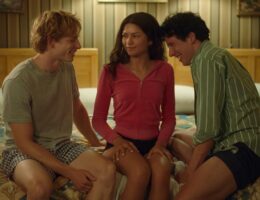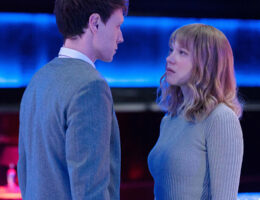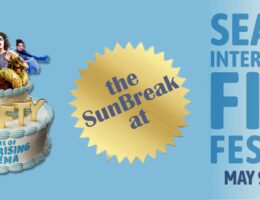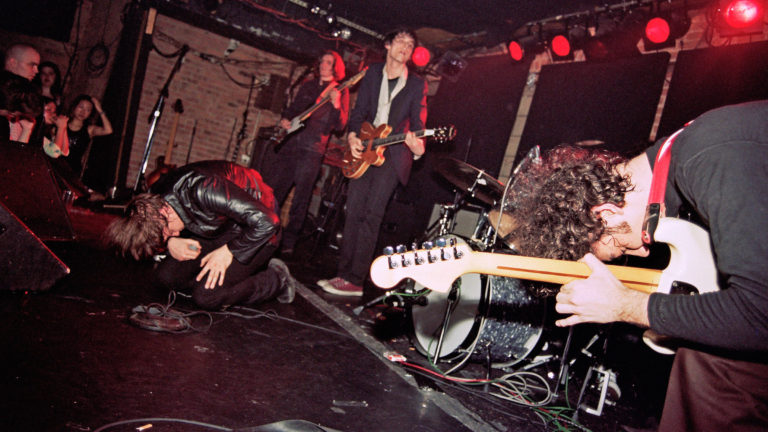Meet Me in the Bathroom (2021 | USA | 105 minutes | Dylan Southern and Will Lovelace)
The rest of you will most certainly dive headlong into Sundance’s ample genre programming for legitimate horror movies, but I can’t think of any or them more terrifying to the ego than sitting down for a music documentary about a bunch of “era-defining” bands as a way of being forced to confront the fact that the soundtrack from your early twenties has now aged into fodder for the archival treatment. Working from groundwork laid by Lizzy Goodman’s book of the same title, directors Dylan Southern and Will Lovelace have assembled a clear-eyed collage of the “rebirth of rock” that exploded from New York City in the early 2000s.
Largely tracking the spectacular rise of the Strokes, their film captures a few extremely formative years in the life of Lower East Side and Brooklyn contemporaries like the Moldy Peaches, the Yeah Yeah Yeahs, Interpol, and the emergence of LCD Soundsystem. I was perhaps too overwhelmed by some of the individual moments to have a sense of whether the mostly observational documentary had a specific point of view beyond “all of this happened”, but it is most definitely successful in terms of capturing a moment. Whether you were a part of this scene or an admirer from afar (like me) or simply a budding musical historian with an interest in a ground-level view of this tumultuous slice of American history, the collection of performance footage, candid slices of life, and intimate audio interviews will provide a powerful blast of aughtstalgia.
Some highlights, in 2000s-era listicle fashion:
- Karen O is a fan of Dirty Dancing. This early audio interview initially seems incongruous and frivolous, but really sets up the outsider fragility of being one of the few female fronts of the wave of rock acts bursting onto the scene.
- In 1999 the Moldy Peaches could afford an apartment on the Lower East Side!
- One gets the sense that by virtue of her maturity, sobriety, and unlikely friendship with Julian Casablancas, Kimya Dawson just might be the only person involved in the whirlwind early days of the Strokes who has any direct memories of their whirlwind rise to success unclouded by copious amounts of drugs and alcohol.
- The first time that by soul truly levitated outside my body was during a grainy black and white clip of Paul Banks performing an early draft of an Interpol song with only an acoustic guitar during a basement open mic night.
- Karen O meeting Nick Zinner cute at a bar, deciding they should start a band, and somehow cramming to write six songs to open for the White Stripes at the Mercury Lounge via a personal connection with the tour’s manager is just the history of all music ascents of this era.
- The way that everyone on the east coast, including baby Karen O with her residual traces of a Jersey shore accent, said the words “Yeah Yeah Yeahs” as three rapid clipped syllables .
- Footage from the 9/11 terrorist attacks, including members of Interpol walking around in the rubble, remains chilling and incomprehensible all these decades later.
- Remember when the concept of a “Brooklyn Band” was new? And how quickly Williamsburg was cannibalized?
- Will Lovelace already made an exceptional documentary about the “end” of LCD Soundsystem (Shut Up and Play the Hits) so it’s fun that he gets this opportunity to track its origin story, from James Murphy sleeping on an inflatable mattress in his office, producing a record for delusional Irish DJ, getting permission from his therapist to try ecstasy, starting a highly influential record label, out-alpha-ing the Rapture, and being spurned to record his own music after in response to his seething resentment of LimeWire DJs cutting into his recordhead marketshare.
- Remember the Rapture? People called them “The Disco Strokes”. What a time.
- Remember LimeWire?
- All the stuff about the rise of the Strokes, particularly Julian Casablancas’s prodigious writing of all of the band’s songs for the first two albums and growing discomfort with fame, is just terrific and well observed.
- As is Interpol’s simmering sadness over being nowhere near as cool or popular as the Strokes despite their very best efforts to look and sound cooler than them.
- The Carlos D’s Herpes Scandal of the early 2000s is not captured here directly, but sort of gets a subtweet for the real fans.
- The way that the documentary slowly introduces the sad vampiric presence of Ryan Adams before setting him up as a villainous figure that nearly tore the Strokes asunder through feeding Albert Hammond Jr’s anxieties with mountains of heroin is a masterful stroke of filmmaking.
- Similarly, there’s a frame of Courtney Love and Winona Ryder that accompanies a story about the duo shouting from the street to get Julian Casablancas to “come be famous with us” that should be framed and displayed prominently in the Museum of Modern Art.
- James Murphy’s hatred of e-mail remains almost as amusing as the fact that he pulled together a band from the ether less than ten days before an international tour.
- The film also knows that when one has access to an unbroken take of Karen O moving herself to tears for the “Maps” video, you show the whole thing from start to finish. You can’t improve on perfection.
I imagine that everyone will have their own lists of moments that ignite their memories with jolts of electricity. For that alone, it’s worth firing up this documentary, basking in the footage of bands being young, in love with each other, crammed into dive bar booths, and climbing from wood paneled basements to dingy clubs to huge arenas of too-adoring fans. Preferably after your usual bedtime, if only as an pandemic approximation of what it felt like to be out late at night.
Meet Me in the Bathroom played in the Sundance Film Festival’s Midnight’s section; it has a second screening today (January 25th) and will be released by Vice Films later this year.




